
Climate is an extremely complex system in which all elements are interconnected. Among them, water is one of paramount importance. Water presents itself in our planet as vapor, liquid water, and ice. The phase changes and water vapor transportation allows the redistribution of energy in the climate system. Moreover, water vapor is the most powerful and abundant greenhouse gas, but it is not directly involved in global warming because its concentration is regulated by temperature rather than anthropogenic emissions.
Water vapor emissions result in condensation and, therefore, they have very little residence time. The same would happen if water vapor was taken away: liquid water would evaporate to regenerate the water vapor concentration. In any case, it is considered that water vapor constitutes a feedback in the climate system: if the temperature rises, the atmosphere is able to accept more water vapor, which enhances its radiative effect as a greenhouse gas and therefore increases the temperature even more. Hence, it is very important to understand properly the radiative effects of water vapor in order to predict accurately the effects of global warming and anthropogenic emissions of greenhouse gases.
A greenhouse gas generally allows short-wave radiation (radiation coming from the Sun in form of ultra-violet, visible, and near infra-red light) enter the atmosphere, but it absorbs and reemits long-wave radiation (radiation coming from the Earth’s surface and atmosphere) back to the surface. In other words, it allows heating of the climate system but blocks its cooling. In order to study the effects of water vapor in short-wave radiation, Vaquero-Martínez et al. defined the water vapor radiative effect (WVRE) as the instantaneous net change in radiation if all water vapor in the atmosphere disappears. It was analyzed both at the surface and at the top of the atmosphere.
Methodology
In order to estimate the fluxes of radiation, the radiative transfer model SBDART was used. This is a program that allows simulating the behavior of radiation throughout the atmosphere. In order to run the code, some parameter is needed as input, some related to geometric properties (such as the solar zenith angle, SZA, or the distance between the Earth and the Sun), others are about the composition of the atmosphere (concentration of gases like ozone, water vapor, and so on). Spanish stations (see Figure 1) were used to retrieve water vapor data from GPS measurements, and other information was taken from ERA-Interim reanalysis. The model was run twice, one with the actual state of the atmosphere, and another setting the water vapor to 0 (dry atmosphere). Then, WVRE was computed as the difference between net radiation in both cases. Net flux for ‘real atmosphere’ minus net flux for ‘dry atmosphere.’
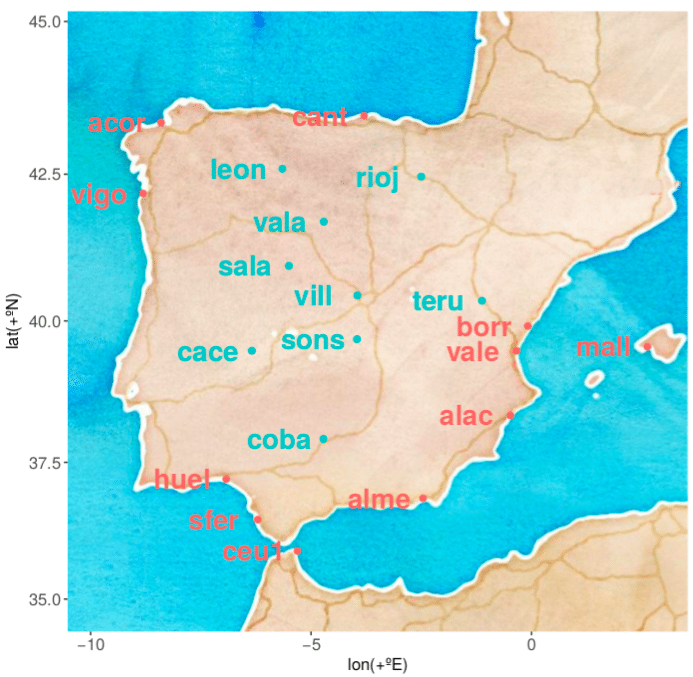
Fig. 1. Location of the twenty stations selected. Coastal stations are written in red and inland stations in blue. (Republished with permission from Elsevier)
Effects at surface
At the surface, an empirical relation (see Figure 2) was found between water vapor effects and the concentration of water vapor (or column integrated water vapor, IWV) and SZA.

where μ = cos SZA, a = (63 ± 1) Wm−2, b = 0.2661 ± 0.0003 and c = 0.7679 ± 0.0003. For instance, for SZA = 60º the effects were between −100 (IWV = 39.8 mm) and −38.7 Wm−2 (IWV = 1.4 mm). This points out the high radiative effect of water vapor if compared to previous studies report for clouds and aerosols values between −50 and −19 Wm−2, and −69 Wm−2 for the combined effect of both clouds and aerosols. It must be noticed that while the atmosphere can have no clouds or (almost) no aerosols, there are no cases in which it has no water vapor, but this still shows the high effect of water vapor in the atmospheric radiative balance. Moreover, the coefficient b is interpreted as the ratio between relative changes in WVRE and relative changes in IWV, that is to say, a change of 1% in IWV would cause a change of b% (≃ 0.27 % in WVRE. This is similar to the Radiation Amplification Factor (RAF) used as a measure of the sensitivity of ultraviolet solar radiation to changes in total ozono column (McKenzie et al. 1991).
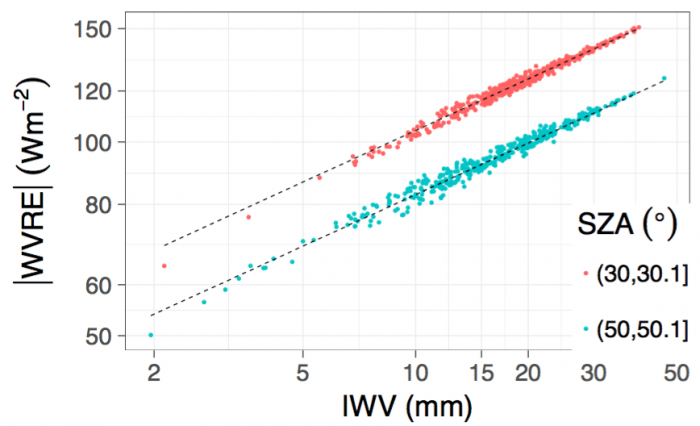
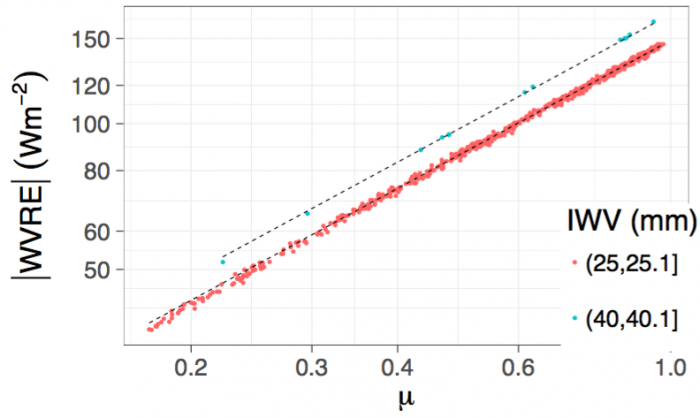
Fig. 2. WVRE against IWV (up) and μ (down) in a log-log plot. The dashed, black lines show the fit. The legends show the intervals of SZA and IWV values considered. (Republished with permission from Elsevier)
Heating rates
The heating rates due to water vapor were also calculated. The heating rate is a magnitude that expresses the increase in temperature that the atmosphere suffers because of radiation absorption per unit of time. Since the water vapor has absorption bands in short-wave, the heating rates were positive, between 0.2 and 1.5 Kday−1. In Figure 3, heating rates showed both a seasonal and a daily cycle. At central hours of the day, the heating rates are larger than at dawn or sunset, and effects at summer are stronger than at winter. This is related to the presence of more/less solar radiation, and to the fact that at higher temperatures IWV is larger.
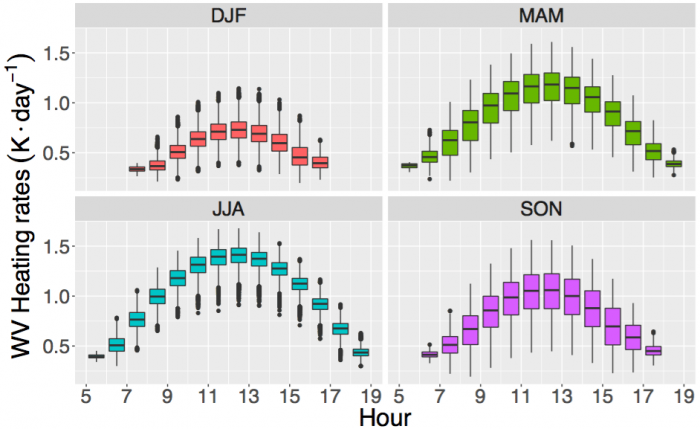
Fig. 3. Boxplot of heating rates according to seasonality and hour of the day. (Republished with permission from Elsevier)
Effect at top of the atmosphere
Effects at top of the atmosphere were calculated as well. They follow a similar empirical relationship (see Figure 4), but in this case, the albedo (the fraction of radiation that is reflected at the surface) was also included in the expression:
where α is the albedo, aTOP = (96±1) Wm−2, bTOP = 0.2264 ± 0.0003, cTOP = 0.8785 ± 0.0003 and dTOP = 0.933 ± 0.002. For instance, the SZA = 60º the effect at TOA were between 11.3 (IWV = 1.4 mm) and 22.3 Wm−2 (IWV = 39.8 mm). So the effect is weaker in the TOA.
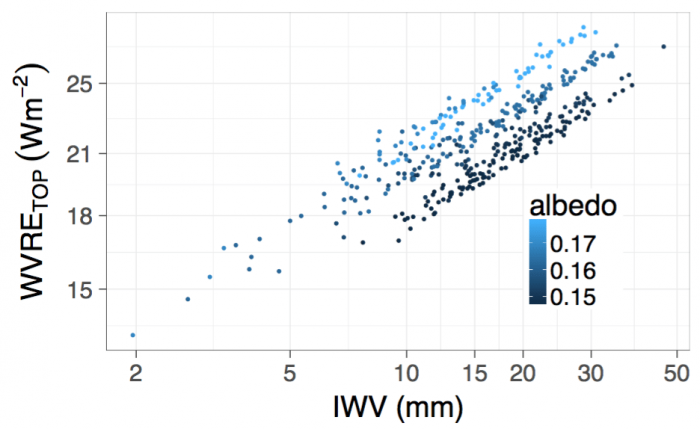
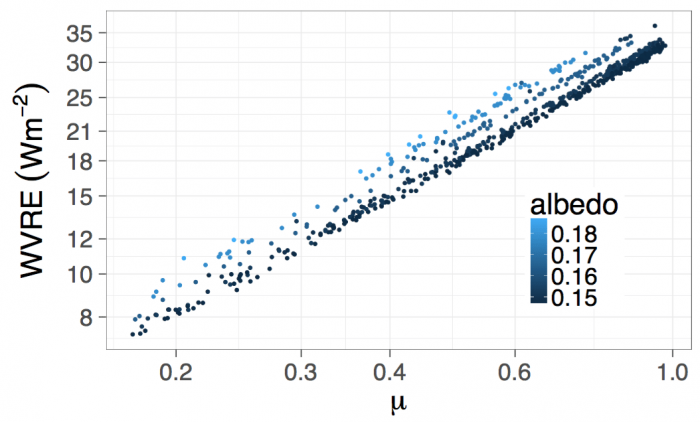
Fig. 4. WVRE against IWV (up) and μ (down) in a log-log plot. The legends show the intervals of SZA and IWV values considered. (Republished with permission from Elsevier)
These findings are described in the article entitled Water vapor radiative effects on short-wave radiation in Spain, recently published in the journal Atmospheric Research. This work was conducted by Javier Vaquero-Martínez and Manuel Antón from the Universidad de Extremadura, José Pablo Ortiz de Galisteo and Victoria E. Cachorro from the Universidad de Valladolid, and Roberto Román from the University of Granada.









